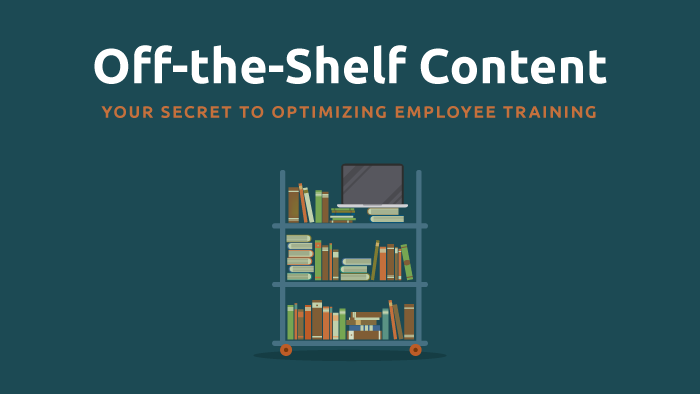Instructional Designers (IDs) play a critical role in the learning and development (L&D) process. They are responsible for evaluating elearning materials, designing curriculum, collaborating with subject matter experts (SMEs), developing engaging training content, and aligning learning experiences with organizational goals. Instructional designers are the architects behind the employee learning journey—ensuring each training initiative is purposeful, effective, and measurable.
So, when it comes to off-the-shelf training courses, IDs may feel like their toes are being stepped on. However, that shouldn’t be the case. There are benefits to using both in-house content and off-the-shelf elearning content providers within the same organization. In fact, combining both strategies creates a more scalable and balanced L&D ecosystem.
- Rather than reinventing the wheel with foundational topics like compliance or communication, instructional designers can lean on trusted off-the-shelf content and use their creativity for custom, high-impact learning experiences.
- Developing custom training is time-intensive, creating just one course can take dozens of hours and cost thousands of dollars. Off-the-shelf courses dramatically reduce both development time and resource costs.
- With off-the-shelf content handling common training needs, Instructional Designers can shift into consulting roles guiding learning needs analyses, curating blends of content, and aligning training with organizational KPIs.
- Pre-built courses allow learners to start training immediately, speeding up feedback loops and nurturing engagement with clear goals and accountability.
- Off-the-shelf doesn’t mean one-size-fits-all. Many solutions allow embedding branding, tailoring assessments, and aligning with internal workflows, giving learners a relevant experience without reinventing content.
Time Spent Creating Training Content
From ideation to design to execution, training takes a significant amount of time to create. An Association of Talent Development study found the average time it took to develop different types of training:
- Instructor-led classroom training: ~67 hours
- Instructor-led online training: ~55 hours
- Elearning development: 48 to 155 hours depending on interactivity
This means weeks’ worth of time is spent creating a single training module. Without off-the-shelf content, instructional designers would be tied up building training for common topics such as compliance, communication, or customer service—content that already exists through trusted off-the-shelf elearning content providers.
Instead of spending their time reinventing the wheel, instructional designers can leverage off-the-shelf training for foundational skills and focus their energy on creating customized, high-impact programs—like onboarding workflows, sales enablement, and leadership development—tailored to your company’s values and culture.
Cost of Developing Training Content
The cost of training development varies depending on complexity, content length, and the team required. Designing a single course often involves:
- Instructional Designers
- SMEs
- Trainers
- Content developers
- Technical support
Here's a cost breakdown shared by an instructional designer at Sendoso:
Leadership Training
- 13 weeks of development
- ID cost: $18,720
- Trainer cost: $16,250
- Total: $34,970
Sales Training
- 28.6 weeks of development
- ID cost: $41,184
- Trainer cost: $65,000
- Total: $106,184
At these price points, purchasing off-the-shelf training courses for general topics can significantly reduce both direct costs and opportunity costs. Off-the-shelf content acts as a force multiplier—freeing your IDs to focus on strategic initiatives instead of core topics that are already well-documented and available.
Instructional Designers as Strategic Enablers
Hiring an instructional designer is not about having someone build every course from scratch. IDs should be empowered to act as strategic learning consultants within your business. Their expertise lies in:
- Performing training needs analyses
- Auditing learning gaps across departments
- Selecting and curating off-the-shelf elearning content
- Creating blended learning journeys using internal and external resources
- Measuring learning impact using data-driven evaluation models (e.g., Kirkpatrick or Phillips ROI)
By integrating off-the-shelf training content with custom-developed modules, IDs can ensure that learning paths are optimized, timely, and aligned with organizational KPIs.
ROI: Off-the-Shelf Content vs. Hiring an Instructional Designer
Let’s take a closer look at the return on investment (ROI) from two perspectives: hiring an in-house instructional designer versus investing in content from off-the-shelf elearning content providers.
| Category | Hiring an Instructional Designer | Using Off-the-Shelf Content (e.g., BizLibrary) |
|---|---|---|
| Upfront Costs | High (salaries, software, development time) | Medium (subscription/licensing fees) |
| Time to Deployment | Slow (weeks to months) | Fast (immediate access) |
| Scalability | Limited (dependent on ID bandwidth) | High (thousands of ready-to-go courses) |
| Customization Potential | Full control | Moderate (with custom overlays and quizzes) |
| Strategic Value | High for proprietary training | High for core/soft skills and compliance topics |
| Total Cost of Ownership (TCO) | High (resource-heavy) | Lower (minimal internal lift) |
| Long-Term ROI | High when ID is used strategically | High when used for foundational skills + scale |
Bottom line: It’s not either/or. The most efficient organizations use both. BizLibrary’s off-the-shelf content delivers high-quality training with proven outcomes, while IDs ensure that learning experiences are strategic, personalized, and tied to performance outcomes.
Ease of Utilizing Off-the-Shelf Content
What is off-the-shelf training? It's pre-built training content that covers universal learning topics like leadership, communication, time management, and software tools. This content is designed for rapid implementation and wide applicability across industries.
Off-the-shelf training is:
- Plug-and-play—requires no development
- Expert-crafted—developed by specialists in L&D
- Consistent—ensures unified learning experiences across teams
This is beneficial for instructional designers because it offloads the most time-consuming part of their role. Instead of building every course from the ground up, they can shift toward evaluating training effectiveness, facilitating coaching conversations, and driving programmatic improvements.
Time-to-Learning Metrics
What is time-to-learning? Time-to-learning is the total time between the moment that a learner starts a training until they deliver feedback. This metric is critical for organizations focused on agility and effectiveness. With off-the-shelf elearning content, employees can begin learning immediately, drastically reducing the lead time between training request and deployment.
Benefits of fast feedback loops:
- Clearer goals and accountability
- Improved learner engagement
- Quicker iteration on training experiences
Choosing the Right Off-the-Shelf Content
When choosing off-the-shelf content, look for providers that offer:
1. Interactivity
Interactivity refers to how learners interact with the training content, and it provides many benefits to learners.
Learners can freely explore their learning environment how they want and do so at their own pace. Being able to explore freely, employees can develop their decision-making skills in a risk-free environment, and making their own choices keeps engagement high.
Adding in visual components, hyperlinks, etc. that make the content more eye-catching and encourage exploration, result in a better overall learning experience.
2. Quiz Questions and Reinforcement
Using quiz questions throughout or after your training is a great way to measure and test the knowledge of your employees on training topics. There are a variety of question types that can be used, including multiple-choice, true or false, and fill-in-the-blank.
As an added bonus, you can use questions as a learning retention tool. Learners forget 70% of information within the first 24 hours. By sending out review questions on a pre-determined basis, questions can be used to help learners retain information.
BizLibrary offers boosts for lessons within The BizLibrary Collection, which helps reinforce learning by sending questions, surveys, polls, and more to learners to gauge and improve their retention.
Preview a deep dive with expert Meredith Whipple Callahan and discover what she says about accelerating employee success from the moment they walk through the door!
3. Customization Options
Off-the-shelf doesn’t have to mean “one-size-fits-all.” Providers like BizLibrary allow you to:
- Embed branding
- Add your own examples
- Customize assessments
- Align content to internal workflows
This gives your training a cohesive, branded look without needing to build from scratch.
Final Thoughts: Best of Both Worlds
Instructional designers and off-the-shelf training courses are not in competition—they are partners. Organizations that strike the right balance between internal development and external content acquisition benefit from:
- Faster time to training
- Lower development costs
- More strategic L&D investments
- Stronger ROI
With a powerful library of customizable, engaging content and a strategic instructional design team, your learning program can deliver real business impact.
Explore BizLibrary’s off-the-shelf elearning solutions to see how you can elevate your training without sacrificing time, quality, or budget.

